Sound
Razer partnered with THX on the development of the Opus. That means that THX, who is a renowned brand for audio quality, tested the Opus to make sure it met some strict standards for clear vocals and no distortion at high volumes – which I tested and found both to be very accurate.
At its core, Opus is designed to be a wireless on-the-go headset; using Bluetooth 4.2 matched with AAC and APTX codecs for high audio quality. I had no issues connecting to my iPhone 8 and MacBook Pro for playback. With the THX certification, the standard EQ setting from the Opus app has a nice, even response. Highs are very clear without distortion and with controlled lows. These EQ modes can be changed within the Opus app, which weвЂll get into here in a little bit.
I did most of my listening in the THX-certified mode because it was a great flat, even response. With this mode enabled, vocals came through clear and lows hit down low without any distortion, even at high volumes.
One of my favorite ways to test low end is to put on Solar Sailer from the Tron Legacy soundtrack and listen to the deep rumbling as the bass line walks down mixed with the orchestral lines overtop. Opus seemed to keep its frequency response and clarity all the way to the top of the volume dial while still reproducing the low end powerfully without any distortion.
Соединение и управление
- Bluetooth с кодеками SBC и AAC.
- Фирменное приложение для Android и iOS.
Гарнитура несовместима с Google Fast Pair, для подключения необходимо перейти в настройки Bluetooth или воспользоваться фирменным приложением. Качество соединения на высоте, помех нет даже через 2 бетонные стены. Большие скопления людей в беспроводных наушниках и линии электропередач также не помеха для Razer Opus. Звук синхронизирован с видео. Для игр есть геймерский режим, однако производитель не уточняет точные цифры задержек, на слух разницы нет.Функциональность утилиты ограничена эквалайзером и парой настроек. Одна из них — отключение датчиков воспроизведения. По умолчанию при снятии наушников ставится пауза, а после повторного надевания — продолжается воспроизведение. Уровень оставшегося заряда ступенчато отображается в статус-баре или на главной странице приложения.На правой чашке находятся все органы управления — 4 клавиши и индикатор состояния. Кнопки только на первый взгляд кажутся одинаковыми и неотличимыми вслепую. На деле большой палец моментально нащупывает слегка утопленную кнопку паузы, а после и регулировку громкости. Кнопка питания находится ниже и помимо прочего меняет режимы шумоподавления.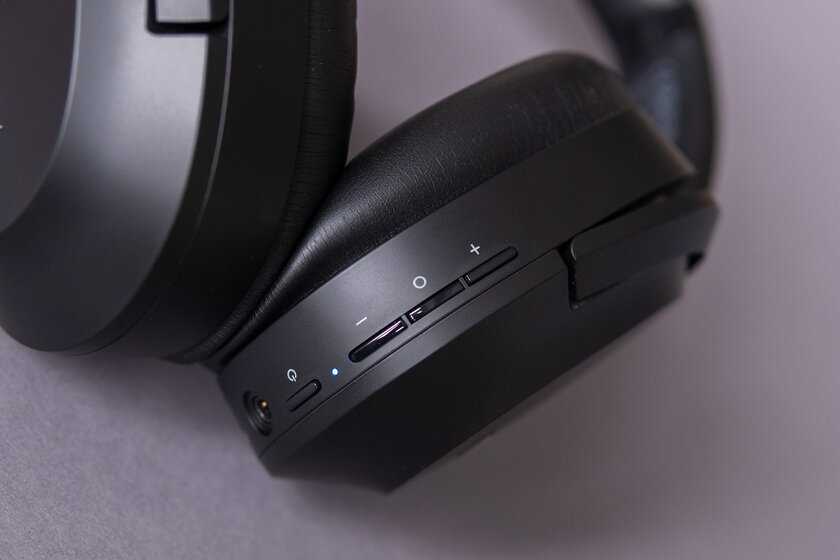 В качестве альтернативы Bluetooth к правой чашке можно подключить AUX. Штатный 1,5-метровый кабель получил Г-образный штекер и необычную прорезиненную оплётку с насечками вдоль всей длины. В проводном режиме доступно шумоподавление, достаточно включить электронику гарнитуры.
В качестве альтернативы Bluetooth к правой чашке можно подключить AUX. Штатный 1,5-метровый кабель получил Г-образный штекер и необычную прорезиненную оплётку с насечками вдоль всей длины. В проводном режиме доступно шумоподавление, достаточно включить электронику гарнитуры.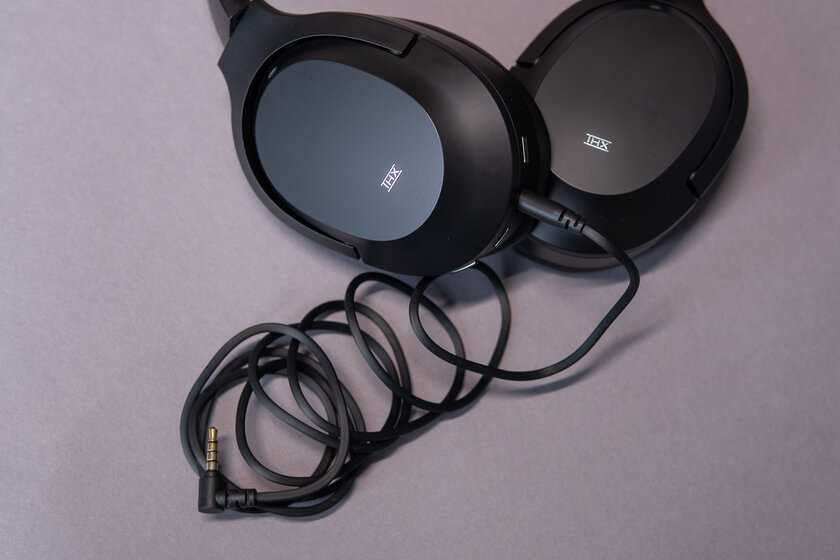
Razer Opus app
Razer created a free Razer Opus mobile app for iOS and Android, which allows you to swap out the general “THX” sound mix for four use-specific EQ setups — “amplified,” “vocal,” “enhanced bass,” and “enhanced clarity.” It also allows you to tweak a couple of settings, including how long the headphones stay on without sound playing (a.k.a.. “Auto Shutoff”).
(Image credit: Laptop Mag)
The app looks great and all of the features work fine but feels a little light. Considering the special THX sound rating and a general emphasis on audio quality, the headphones should provide the freedom to adjust the levels as I see fit. It also seems odd that there are features, like ambient awareness mode that you can only toggle using the onboard controls.
Specs and features
The Razer Opus features 40mm drivers inside a lightweight headset with plush leatherette memory foam ear cushions, weighing in at 265g. It connects by a 3.5mm analog cable (included) or Bluetooth to your phone or PC via AAC, and there’s aptX support. Inside the carrying case is the mentioned 1.5m 3.5mm analog cable, a 30cm USB-C cable for charging, a USB-A to USB-C adapter, as well as the standard airplane analog adapter. Both the 3.5mm and USB-C ports are located on the left can and are easily accessible.
Opus is also equipped with four microphones (two external and four external) used for a mixture of calls and for ANC—more on that later. The microphone call quality is very average, which is to be expected given the over-the-ear design—there is just only so much tuning that can be done to battle the physics of the microphones being so far from your mouth. I didn’t run into any glaring problems during calls, and neither did the recipients.
The battery is stated to last for 25 hours with ANC enabled and around 32 hours with it disabled, but in my testing it fell a bit short of those numbers under constant listening. The stated charging time from a depleted battery is 4 hours was very accurate—there’s no rapid charging for a quick turn around like Sony’s.
The headset includes easy-to-find and satisfyingly clicky buttons alongside the lower parts of the headphones. On the left side is a power button that triggers a pleasing powering up sound effect when turning on and a small status indicator LED next to it signaling the various power states. Above that is the NC/Ambient switch that toggles between active noise cancelling on and off. Press and hold that same button to engage a Quick Attention mode that passes the signal from the outer microphones into the mix and allows you to address someone speaking to you or to boost your awareness of your surroundings.
Unfortunately this feature can’t be enabled as a full time mode–again, like on the WH-1000XM3–as I sometimes like the option to be on for longer than I’m willing to hold the button down for. Hopefully this can be implemented via a software update as it is the feature I missed the most from Sony’s product.
One feature that is appreciated is the auto play/pause that is engaged when putting the headphones on and taking them off. Even most high-end ANC headphones lack that feature, and frankly, it was easier and faster to take the headphones off and pause my music to speak with someone than it was to find and hold down the NC/Ambient button.
On the right can is where the volume up and down buttons are, with a recessed multi-function button placed in between. The middle multi-function button is used for things like play/pause and engaging a phone’s personal assistant. I had no problem finding and engaging these buttons, which are large enough and placed evenly across the back side. The control setup on the Opus is simpler and easier to use than the swipe controls on the WH-1000XM3—a welcome advantage.
The last feature to note is the companion Opus app available on iOS and Android (I tested the Android version), which is unfortunately pretty thin. In it is an icon showing battery level–without an important percentage indicator–a few settings and links, and EQ presets. By default the headphones are loaded with the THX-certified mix, but there are also Amplified, Vocal, Enhanced Bass, and Enhanced Clarity presets that are pretty self explanatory. The app is very simple and lacks many of the basic and advanced features present in more expensive headphones from Sony and Bose.
ANC
Being an on-the-go headset, one of the main features is its active noise cancelling capabilities. With four dedicated microphones placed around the headphones, ANC works great on the Opus headphones. Like most ANC, where it shines is by taking out a lot of low-end room noise. Higher frequencies still make their way in but matched with the passive ANC from the earpads, I found it doing well when I was trying to block out sound at my desk and even while mowing my lawn.
Where it isnвЂt great, though, is whenever it gets windy. I tried going for a run and also a bike ride, and if there is any significant wind, there is some buffeting or wind noise coming in as it passes over the holes for the microphone. I ended up turning the ANC off while running, which still sounded fine to me.
Quick attention mode is enabled by holding the ANC on/off button and gives a quick glimpse at what is actually going on around you. This canвЂt be enabled all of the time, but can only be enabled by holding the button. It will turn off when you let go.
Каково это использовать Razer Opus?
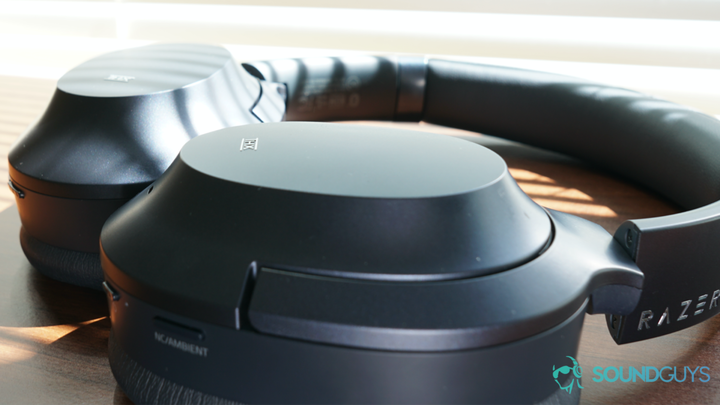
Razer работал с THX, чтобы адаптировать звук наушников к более нейтральной частотной характеристике.
Как я уже упоминал выше, Razer Opus – это обычная пара беспроводных наушников Bluetooth. Они сделаны в основном из пластика, с чехлами из искусственной кожи на наушниках и повязкой на голове. Шарниры наушников поворачиваются, чтобы лежать ровно, и складываются, чтобы поместиться в прилагаемую сумку для переноски. Они могут выглядеть немного производными, но когда исходный материал, из которого они получены, является чем-то таким же хорошим, как флагманские наушники Sony, трудно жаловаться слишком много.
Оголовье создает сильное напряжение, и я никогда не чувствовал, что наушники вот-вот упадут с моей головы, даже при длительных прогулках и пробежках. Тем не менее, я бы не рекомендовал бегать с ними (или выполнять какие-либо тяжелые упражнения), поскольку кожзаменитель действительно накапливает тепло, и пот стал проблемой.
Хотя добиться приличной печати было довольно легко, Razer Opus довольно неудобно носить очки. Учитывая, что Razer предлагает решения, такие как каналы с вырезанными очками, в большинстве своих игровых гарнитур, очень досадно не видеть этого здесь.
Razer Opus поставляется с шнуром TRRS 3,5 мм, зарядным шнуром USB-C, адаптером USB-A и разветвителем 3,5 мм.
В то время как форма этих наушников явно вдохновлена банками Sony, Razer Opus действительно делает свое дело в цене. За 200 долларов вы получите большую часть того, что найдете в более дорогом оригинале, после которого они смоделированы: Bluetooth 4.2, зарядка USB-C, поддержка AAC и aptX и многое другое. Такие предметы роскоши, как сенсорное управление или более широкая поддержка кодеков, отсутствуют, но если вам придется что-то сократить, чтобы достичь более низкой цены, это, вероятно, то, что многие люди выберут.
Razer Opus оснащен обычными встроенными элементами управления, которые можно ожидать, с кнопками питания, шумоподавления, громкости и воспроизведения мультимедиа. Конечно, это не так броско, как другие предложения, но это просто и работает хорошо.
Сопряжение устройства – это немного больно. Bluetooth для нескольких точек не поддерживается, и для входа в режим сопряжения необходимо удерживать кнопку питания дольше, чем требуется, чтобы светодиодный индикатор начал мигать. Если вы не слышите шум сопряжения в наушниках, ожидайте много отклоненных уведомлений о сопряжении.
Конечно, если вы один из немногих счастливчиков со смартфоном, у которого все еще есть разъем для наушников 3,5 мм, Opus также поставляется с шнуром 3,5 мм. Вы можете использовать это соединение и после того, как разрядится аккумулятор гарнитуры. Говоря об этом, мы обнаружили, что Razer Opus продержался 27 часов, 41 минута на одной зарядке с включенным активным шумоподавлением (ANC). С отключенным ANC вы, вероятно, получите еще лучший пробег.
Bottom line
The Razer Opus is a good pair of wireless, active noise-canceling headphones, but not a great one. Though it has comparable sound quality and performance to many of the best Bluetooth headsets in the field, it falters in a few places and lacks the robust features of a best-in-class daily carry headphone.
Luckily for Razer, the Opus has an ace in the hole — its price. At $199, the Opus is substantially cheaper than most of the headsets it’s modeled after, including the , the Bose 700s and Sennheiser’s Momentum 3s. Selling for $100 cheaper than each of these cans, the Razer Opus is a solid “good enough” pick for non-audiophiles looking to make the jump to an over-ear wireless headset with active noise-canceling, without breaking the bank.
App Control
The Razer Opus app for Android and iOS provides some customization options, but it feels limited compared with some other headphone apps. You can switch between five different EQ presets, including THX (default), Amplified, Vocal, Enhanced Bass, and Enhanced Clarity. However, you can’t create a custom EQ preset, even if the app shows a five-band EQ to display what the curve looks like for each preset.
You can change features like Auto Shutoff (how long the headphones stay on without anything being played through them) and Auto Pause/Resume (which automatically pauses music when you take the headphones off, and plays it again when you put them back on). There are no adjustments for the ANC, however, which means you can’t tweak how strong the noise cancellation is. This isn’t surprising for $200, though; customizable ANC usually doesn’t come into play until you hit more expensive models like the $400 Bose Noise Cancelling Headphones 700.
Package & Appearance
These headphones are delivered folded in a soft transport case which comes with a zip and carrying strap. In a small fabric pouch, you will also find two small rolled up cables. Firstly, there is a 3.5 mm jack cable, 130 cm long, with gold-plated plugs to prevent corrosion. The second is the charging cable, a USB cable from USB-A to USB-C that is about 50 cm long. An aeroplane adapter with gold-plated contacts rounds off the package. In addition to the operating instructions, a card with a quick-start guide and an advertising sticker are also included. This is a package that offers everything you would hope for in a pair of headphones that are suitable for everyday use that can also be taken along on trips.
Noise Cancellation
The active noise cancellation here is good at tamping down lower frequencies, but it doesn’t block out higher frequencies as well. While the headphones lessened the rumble of my air conditioner as it pumped out cool air, I could still hear my fans buzzing away in the distance, like white noise.
The ANC doesn’t produce any noticeable hiss on its own, which is an improvement over a common weakness in this price range. It does slightly affect audio performance, however, but it’s not a significant or unpleasant change; when noise cancellation is turned on, bass sounds a bit more powerful, which is actually nice.
This puts the headphones on comparable footing with the Sennheiser HD 450BT, which is a good place to be. If you want headphones that completely block outside noise, you’ll have to look into spending more on the Bose Noise Cancelling Headphones 700 or Bose QuietComfort 35 II.
Features
- ANC technology
- Razer Audio app for customising features
- No auto-pause/play options
The Razer Opus X only supports Bluetooth 5.0 for connectivity, making it a headset exclusively for mobiles and PCs – I had no luck connecting it to any of my consoles.
But once connected, the headset had no issues and I never noticed any audio delay, with the headset staying connected even after I left the room.
Razer offers an app for the Opus X, available on iOS and Android, which lets you tweak a few settings. You can activate ANC (which can also be done on the headset itself), toggle Gaming Mode, and change the Equaliser settings, which gives you the choice of turning on Enhanced Bass, Enhanced Clarity, Vocal, Amplified or staying on Default.

My favourite mode is Enhanced Clarity, as I felt it helped keep vocals and instruments clear when listening to music. And despite the name, I also felt it bought on a deeper bass than the other modes. Gaming Mode gave a little more oomph to mobile games, which is promising for any Candy Crush lovers out there.
The Razer Opus X’s standout feature is undoubtedly the ANC (active noise cancellation). It can be toggled on and off and is very effective against most white noise or conversations happening around you. Over the weeks I used them, I found that ANC worked best in already quiet environments, when in a car or on a train they were no match for the engine noises and weren’t always great against rowdy travellers or crying children. Once noise became loud in my immediate vicinity, it would cut through my music.

The Ambient Mode was also more useful than I expected, as it allowed me to tune into conversations or listen out for a train announcement without needing to faff about removing the headset. When removing the headset though, the lack of auto play/pause was a little annoying and made me more prone to manually altering my audio, rather than using the buttons on the device.
On the battery life front, I was impressed with how long I could get out of them. Razer claims they take three hours to fully charge, and promises up to 30 hours with ANC on, and 40 with ANC off. I was able to wear the headset for a good four days, with a mix of ANC turned off and on, until they died.
Leaving the headset charging for half an hour to an hour gave me several hours of use, which is a good option if you’re in a rush. Overall I felt it was a respectable effort, as I never felt worried they would suddenly run out of charge, and the LED light turning orange on the right earcup helpfully alerts you if it’s time to give them a power boost.
Впечатления от использования
Razer Hammerhead True Wireless мгновенно соединяются с ПК или смартфоном и выдают хороший запас громкости – мне хватало 40-50%, чтобы звучание было комфортным, при том что я люблю громко слушать музыку. Сенсорное управление позволяет контролировать все, что связано со звуком, не вынимая смартфон из сумки – в холодное время года эта возможность не будет лишней. Однако изучение списка команд и привыкание к особенностям управления – например, одиночное касание выполняется с небольшой задержкой, чтобы исключить ложные нажатия – займет некоторое время.

Razer знает толк в разработке наушников, поэтому в качестве звучания новых Hammerhead True Wireless сомнений не возникало. Что и подтвердилось на практике: 10-миллиметровые динамики выдают сочный бас, чистые верхние и средние частоты. Звук сбалансирован, гаджет уверенно справляется с любым жанром, одинаково хорошо раскрывает многообразие инструментов в классических композициях и вызывает приятную вибрацию в мощных хип-хоп треках. За отсутствием пресета THX, возможно, придется немного повозиться с настройками эквалайзера, однако в любом случае гарнитура способна на многое.
Активное шумоподавление надежно отсекает посторонние звуки, а если нужно переключить внимание на внешний источник, у девайса имеется режим быстрого внимания, который улавливает окружение с помощью микрофонов – это позволяет, например, беседовать с другими людьми не вынимая наушники из ушей. Еще один бонус к мобильности и комфорту
К разговорному микрофону нет вопросов: собеседники отлично слышат меня, голос передается чисто и без искажений.
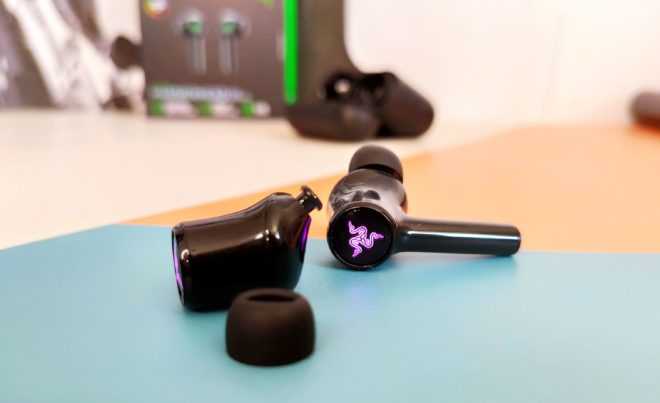
Мобильные гарнитуры Razer оснащены игровым режимом, который обеспечивает низкую задержку соединения – до 60 мс. В списке – модели Razer Kraken BT Kitty Edition, Razer Hammerhead True Wireless, Razer Hammerhead True Wireless Pro, Razer Hammerhead True Wireless X, а теперь и Razer Hammerhead True Wireless (2021). Игровой режим устраняет отставание звука от изображения, в результате чего беспроводные наушники работают так же быстро, как и проводные.
Новая модель полностью оправдывает свою принадлежность к геймерскому бренду. Она была протестирована в Call of Duty Mobile и PUBG Mobile, где показала хорошее позиционирование звука, а с игровым режимом еще и устранила задержки. Конечно, это не дает прибавку к скиллу, однако позволяет более эффективно считывать ситуации на поле боя.
Комплектация и дизайн
Небольшая картонная коробка в черно-зеленых тонах содержит принт с изображением наушников и основную информацию о них: на лицевой стороне крупно красуется надпись «Razer Chroma RGB», а чуть ниже перечислены другие особенности девайса.
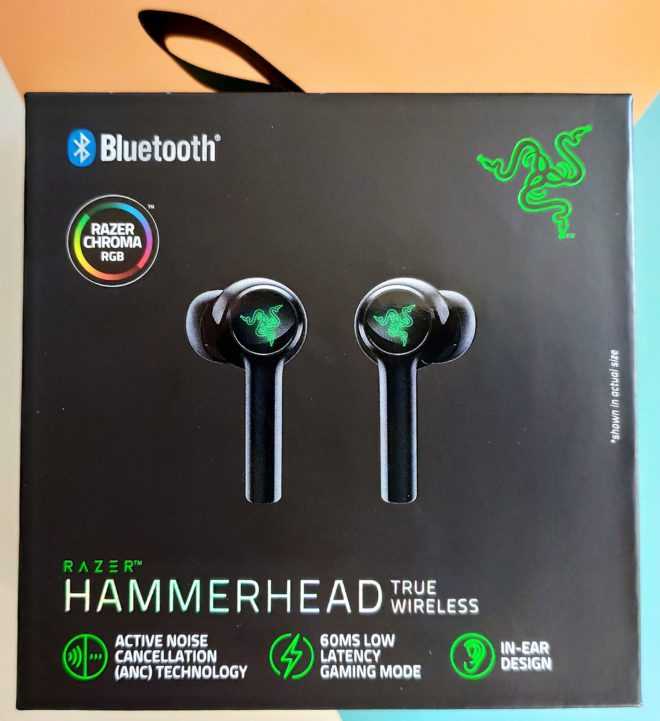
Под крышкой вы найдете сами наушники Razer Hammerhead True Wireless (2021), зарядный кейс, короткий кабель USB-C, комплект сменных амбушюр, а также руководство по эксплуатации, приветственное письмо и комплект наклеек.
Новинка унаследовала дизайн от более дорогих Razer Hammerhead True Wireless Pro: такой же формы корпус в виде крупноватого «бочонка» с длинной ножкой, такая же форма амбушюров, и зарядный футляр тоже вытянут в высоту, а не в длину, как это было с оригинальными Hammerhead TW.

Разница лишь в том, что Pro-модель матовая, тогда как новенькие Hammerhead TW глянцевые (их непросто достать из кейса, и они очень быстро собирают отпечатки пальцев). К тому же, свежий девайс от Razer обзавелся подсветкой на торцах наушников, аккурат там, где находится сенсорная площадка для управления устройством. Подсветка есть и на недавно вышедших Razer Hammerhead True Wireless X, но одноцветная, зеленого цвета, тогда как у новой модели – настраиваемая RGB
С такими наушниками обязательно привлечешь внимание

В комплекте с гарнитурой производитель кладет три пары амбушюр – размеров S, L и M, что позволяет подобрать нужный вариант под размер своего уха. Держатся наушники очень крепко, не выпадают даже при сильной тряске – тому способствует эргономичная форма корпуса, очень, на мой взгляд, удачная.

Футляр Razer Hammerhead True Wireless матовый, с откидывающейся крышкой с названием бренда на ней. Она надежно фиксирует наушники внутри, и для ее открытия необходимо приложить небольшое усилие. На лицевой стороне кейса разместился небольшой индикатор: он светится зеленым, оранжевым и красным в зависимости от уровня заряда аккумулятора. На нижнем торце – порт USB-C для зарядки.

По сумме впечатлений – за форму корпуса и эргономику уверенно отдаем положительный балл, как и за удобный футляр, но хотелось бы меньше глянца – и с практической, и с эстетической точки зрения.
Часто задаваемые вопросы
Как подключить новые наушники Razer Hammerhead True Wireless к устройству с поддержкой Bluetooth?
Находясь на расстоянии не более 1 метра от мобильного устройства, откройте крышку зарядного кейса, не вынимая наушников, и убедитесь, что аккумулятор достаточно заряжен, проверив светодиодный индикатор. Razer Hammerhead True Wireless теперь находится в режиме сопряжения Bluetooth.
Перейдите в настройки Bluetooth вашего устройства, чтобы включить Bluetooth, затем найдите и подключитесь к «Razer Hammerhead TWS (2nd Gen)». Вы услышите звуковой сигнал «Bluetooth Connected» из наушников, подтверждающий, что они подключены к вашему устройству.
Примечание. После сопряжения наушников с устройством они будут автоматически пытаться подключиться к последнему сопряженному устройству каждый раз при открытии крышки зарядного футляра или при включении наушников.
На сколько хватает заряда батареи новых Razer Hammerhead True Wireless?
ВЫКЛЮЧЕННЫЕ ПОДСВЕТКА И ANC До 32,5 часов: 6,5 часов в наушниках + 26 часов в зарядном чехле(4 зарядки наушников) Протестировано на устройстве iOS при 50% громкости.
ВКЛЮЧЕННАЯ ПОДСВЕТКА И ВЫКЛЮЧЕННЫЙ ANC До 27,5 часов: 5,5 часов в наушниках + 22 часа в зарядном чехле(4 зарядки наушников) Протестировано на устройстве iOS при 50% громкости и яркости с эффектом дыхания.
ВЫКЛЮЧЕННАЯ ПОДСВЕТКА И ВКЛЮЧЕННЫЙ ANC До 22,5 часов: 4,5 в наушниках + 18 часов в зарядном чехле(4 зарядки наушников) Протестировано на устройстве iOS при громкости 50% и активном шумоподавлении.
ВКЛЮЧЕННЫЕ ПОДСВЕТКА И ANC До 20 часов: 4 часа в наушниках + 16 часов в зарядном чехле(4 зарядки наушников) Протестировано на устройстве iOS при 50% громкости и яркости при включенном эффекте дыхания и активном шумоподавлении.
Как максимально эффективно использовать мои новые наушники Razer Hammerhead True Wireless?
Загрузите и установите мобильное приложение Razer Audio в магазинах приложений для iOS или Android. Приложение позволяет вам выбирать различные настройки эквалайзера или задавать собственные, управлять световыми эффектами и яркостью Razer Chroma RGB, переназначать сенсорные жесты, проверять состояние батареи на наушниках, включать активное шумоподавление и игровой режим с низкой задержкой, включать быстрое сопряжение, обновлять прошивку, а также получить дополнительную информацию о своем устройстве.
Как включить активное шумоподавление и режим быстрого внимания?
Есть два способа. Первый способ — нажать и удерживать 2 секунды на любом наушнике. Вы услышите звуковые сигналы «ANC On» или «Ambient On», подтверждающие активацию каждого режима. Повторное выполнение того же жеста приведет к циклическому переключению между двумя настройками. Вы также можете переключаться между активным шумоподавлением и режимом быстрого внимания в мобильном приложении Razer Audio.

Design: 8/10
Available in black or blue, the Opus headphones have a crisp design with no unnecessary distractions. The tech giant has skipped its signature green accents for subtle THX and Razer logos on the ear cups and the headband, making the cans understated and bound to appeal to mainstream consumers.
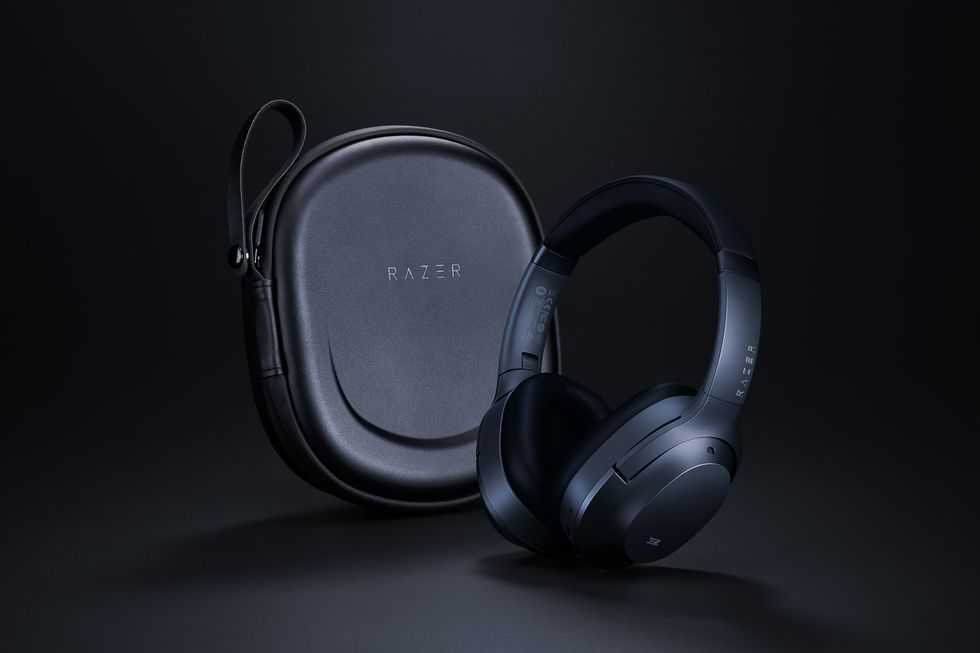 Razer
Razer
Some might find the polycarbonate finish of the Razer Opus a tad generic and that’s understandable — most noise-canceling headphones under $200 follow the same design pattern. For comparison, the Bowers & Wilkins PX7 headphones have vastly more memorable looks and tactility, but they will cost you.
Солидный, стильный звук
Наушники Opus – это первый шаг Razer к активному шумоподавлению без акцента на играх: они обеспечивают мощный звук с превосходной точностью воспроизведения высоких частот. У них немного слабые басы, и ANC не самый мощный, но это все же очень хорошие наушники за свою цену, особенно если вам нравится заниженный дизайн. Тем не менее, наушники Sennheiser HD 450BT остаются нашим выбором для доступного шумоподавления, с лучшим звуком и качеством ANC по той же цене. Между тем, если вам нужно действительно мощное шумоподавление, наушники Bose Noise Canceling Headphones 700 остаются лучшими из протестированных нами, хотя и стоят вдвое дороже. А если вам просто нужен качественный звук без активного шумоподавления, наушники Status Audio BT One предлагают удивительно высокие характеристики за 100 долларов.
Суть
Если вы не ожидаете сильных басов, наушники Razer Opus предлагают активное шумоподавление и четкий, чистый звук по разумной цене.
Conclusion
For the price point the Razer Opus is above average when it comes to audio quality and comfort, but is below average in terms of active noise cancelling and overall features. Aiming for $200 price is a great move from Razer for a first attempt into the lifestyle product and is more aggressive than most of their gaming offerings. It get’s you close to the quality of higher priced flagship offerings from Sony and Bose, but at a steep discount.
With the Sony WH-1000XM3 repeatedly being discounted below $300, and even as low $250, it becomes a tougher proposition—and the discounts will only get steeper and more frequent as the WH-1000XM4 draws near. But thanks to the THX tuning, comfortable design, and easy to use controls the Razer Opus is still worth a look.
Razer Opus ambient awareness hearing mode
As a counter-balance to its noise cancellation, the Razer Opus also offers an “ambient awareness” mode, which deactivates the internal noise-cancelling speakers, and uses the external mics to amplify ambient noise, counteracting the sound blocked by the headphones’ ear cups.
There’s definitely a difference between what you can hear in ambient awareness mode versus turning your audio off, but I’m not sure it’s helpful in many cases. Given that the audio doesn’t play, and it’s only meant to be used in short bursts, you’re probably better off just flipping your headset off since the audio will automatically pause anyway.
Razer Opus controls
The Opus’s controls are fairly conventional, relying primarily on onboard controls, although there are a pair of gesture-based controls for auto-pause and auto-play. The onboard controls on each can are slim, rounded rectangular buttons. On the left can, you have a power button and ANC toggle, along with a 3.5mm jack and USB-C port for charging. The right can sports media controls — play/pause, volume up, and volume down.
(Image credit: Laptop Mag)
Some of the buttons, including power and the ANC toggle, control additional features. Holding down power, as with most headsets, activates Bluetooth pairing mode. Holding the noise-canceling button activates ambient awareness or “quick conversation” mode.
More interesting is the Razer Opus’s auto-pause and auto-play features, a gesture control that automatically pauses the song or video you’re listening to when you lift the headset, then turns it back on if you put them back on within a minute or so.
(Image credit: Laptop Mag)
The pause feature works perfectly. It always pauses, whether you lift the headphones off your head or tilt them back. At the same time, it doesn’t pause prematurely: You won’t trigger it by tilting the headset on your head or adjusting the fit.
The auto-play feature, on the other hand, is pretty inconsistent. Forgetting that it only works when you put the headset back on shortly after auto-pausing, which limits its usefulness quite a bit, there is no guaranteed movement or gesture that will get the Opus to recognize that you’re putting the headset on. Overall, I think the auto-pause feature is genius and found myself relying on it without even realizing it. Is it sad that auto-play doesn’t work as well? Yeah, but I don’t really miss it, either.
Аудио производительность
Наушники Opus с сертификатом THX настроены для обеспечения полного, чистого звука, хотя они не обеспечивают много глубоких басов. У бас-барабанов в песне Fleetwood Mac «The Chain» достаточно мощности, чтобы удержать ритм, но они не имеют небольшой силы на низких частотах. Тем не менее, гитарные ноты звучат невероятно чисто, с отличным стереоизображением и даже небольшим ощущением пространства вокруг наушников (эффект, который чаще наблюдается в дорогих моделях с открытой спинкой). Предустановка THX EQ звучит сбалансированно и полно, несмотря на отсутствие басов, хотя предустановка Enhanced Bass не очень помогает добавить в микс присутствие низких частот.
Да, «Roundabout» здесь звучит приятно четким и полным, с открывающимися звуками акустической гитары, получающими хорошее ощущение низко-среднего резонанса и обилие струнной текстуры. Электрический бас не выделяется в миксе и в конечном итоге находится немного на заднем плане, но гитарные удары, тарелки и вокал звучат с хорошим балансом и легко различимы друг на друге.
Ведущий бэкбит в песне The Crystal Method «Born Too Slow» имеет достаточно низкую и среднюю мощь, чтобы сохранить темп загруженного трека, хотя, опять же, он не достигает достаточно низких частот в диапазоне низких частот, чтобы звучать действительно зловеще. Кричащий вокал и гитарные риффы звучат очень эффектно, а малые барабаны и тарелки делают трек захватывающим даже с относительно слабым бас-барабаном.






























